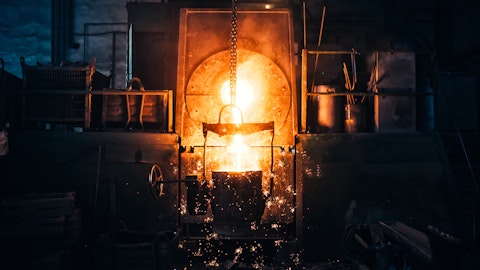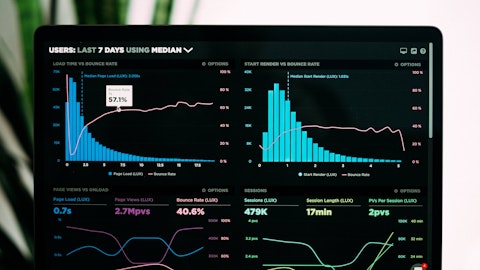Aditya Mittal: Yes, sure. Look, Myles, we have — Sorry, Tom, anyway, let me answer the question. In terms of Calvert, we are very focused on increasing and growing our business. We have talked about the EAF, the first EAF being commissioned in 2024. And we’re committed to doubling the capacity, electric capacity at Calvert. And we have plans for a second EAF. If you look on a broader basis, you will notice that we have renamed our NAFTA segment. I mean, NAFTA no longer existed as USMCA, so now it’s called North America, which is a core growth region for the company. What does that really mean? It means that we have world class assets, an excellent team and the best automotive franchise. We have almost 13.8 million tonnes of hot rolled capacity in North America.
And if you include our Canadian mining business, almost 40% of group EBITDA is coming from North America. The other very interesting aspect of our business is that we are decarbonized to a large degree, if you look at our Mexican business, it’s operating with a DRI and EAFs. Calvert, as you know is electric, and we have plans to decarbonize Dofasco. So we have a very strong platform to continue to grow and develop the business. In terms of Calvert’s role in the future, I think the role really is to expand and develop the business as a Calvert site.
Tom Zhang: Understood. Fair enough. And then the second one, just on the strategic envelope, you’ve sort of given the waterfall chart of various projects, all coming online at various stages of 2024, maybe more of a sort of housekeeping question, but what’s the sort of phasing of earnings from these projects? Because I guess a lot of them come online in 2024, but there’s various ramp up stages. I guess Liberia is the main one where you’re not seeing full impact until probably 2026, when it’s at full run rate. So, yeah, if you have a sort of number of percentage of this $850 million that’s coming online next year, how much of that is actually recognized in 2024? How much is 2025? How much is 2026?
Aditya Mittal: Yes. Tom, I’ll let Genuino to answer that.
Genuino Christino: Thank you. Tom, I mean, we — as you can see there, so we are guiding for about $900 million worth of EBITDA in projects to be completed this year, right? I mean, some of them really towards the end of the year. So we should not really see a significant impact from the projects in 2024. But I would expect to see a large part of it already in 2025, with the exception of Liberia, as we discussed, Liberia being, of course, about $300 million of the total. I would expect to see perhaps half of it in 2025, and then the full benefit in 2026.
Tom Zhang: Thank you. So sorry, just to clarify, half in 2025, that means half of the Liberia benefit or half of the…
Genuino Christino: That’s what I would guide today.
Tom Zhang: Got it. Thank you. I’ll turn it back.
Daniel Fairclough: Great. Thanks, Tom. So we will move now to a question from Max at Oddo.
Maxime Kogge: Yes, good afternoon. Thanks for taking my question. So yes, first question is on U.S. steel. Now that the process is behind all of us, can you confirm that you had made an offer for the unit, and can you give us — can you tell us also, I mean, why you think it was not retained by U.S. steel? That would be my first question.
Aditya Mittal: Max, thank you for your question. As you know, ArcelorMittal has a longstanding policy, I’m not commenting on M&A, so we have not commented in the past and we won’t be commenting now. I think there have been a lot of questions on North America, so I won’t repeat what I just said. But suffice to say, we are committed to our business in North America. We have a very strong platform and we intend to build on that.
Maxime Kogge: Okay, okay, fair enough. So my second question is on SCIS. It’s been now moved to other. So is it fair to assume that basically for the foreseeable future, the two remaining units, South Africa and Ukraine, will remain loss making. I think that in Ukraine, local management was hopeful that production could increase quite significantly this year versus 2023. I mean, what’s your view on that? And in South Africa, are you still committed to withdrawing from the long segment and what would be the benefits in terms of margins from that withdrawal?
Aditya Mittal: Sure. So let me address your question. So first of all, South Africa is not a bit negative in 2023. We do have, of course, issues, problems with the long business. That’s why we took an impairment there. And we are in discussions with the government in South Africa with various stakeholders to try to preserve the business, the long business. So South Africa is a bit of positive. Ukraine and Kazakhstan, as we know, they were EBITDA negative in 2023. Kazakhstan is now out. That’s about $100 million of EBITDA loss that we should not see again repeating in 2024. And I think the Ukrainian team is doing a great job, minimizing the losses. Today, we are below really $100 million, even less when it comes to free cash.
So I think it’s — given the circumstances, it’s going relatively well. What we see more recently, which give us also some optimism is that the Black Sea is showing signs of normalizing or at least there are some routes that our unit can now start to use. So that should provide a boost to our exports, if that materialize, if that is sustainable, we will see that is going well. And we should not forget that we see Ukraine as in the future when situation normalize, giving the strong asset base and the quality of the iron ore that we have available can be an important part of our European strategy as well.
Maxime Kogge: Okay, okay. And the last one, if I may, on the — what’s your course of action and what’s your residual exposure to the unit? I mean, would you lose any cash if the unit went into administration?
Aditya Mittal: Well, as you know, we have taken the impairment now in Q4, and we are not today subject to any other commitment. So at this stage, we don’t expect any more liabilities or costs associated with the asset.
Maxime Kogge: Okay, thank you. I’ll go back to the queue.
Daniel Fairclough: Great. Thank you, Max. So we’ll move now to a question from Moses at JP Morgan.
Moses Ola: Hi, everyone. Thank you very much for taking my question. So the first one I had, please, is just on the ongoing share buyback with the materially strong free cash flow generation in this quarter. Just wanted to understand if the May 2025 target for the completion of the ongoing share buyback remains relevant or if there perhaps is a case for reauthorization sooner. That’s my first question, please.
Aditya Mittal: Yes. Moses, so, look, I think we have — I was very pleased with what we achieved in quarter four. So we did well. We took advantage of the very weak share price. We continue to buyback as we speak. You can see the disclosures on a weekly basis. We will continue that. So we are very confident that the group will continue to generate good levels of free cash this year. We have said that we want to keep, and we will keep our capital allocation policy. So 50% of that will continue to be minimum, 50% will be dedicated to the buybacks. So at this point, we feel confident that, first of all, we’re going to be able to complete the program by May next year at the latest. And we’ll see as and when we cross that bridge, we will then, of course, ask for new authorization for more buybacks.
Moses Ola: Okay, thank you. So my second question is just on pricing power here in Europe. We’ve seen disruptions at the Red Sea, import, lower demand for imports. Just wanted to see, from what you’re seeing currently, if you’re seeing greater pricing power due to greater demand for domestic material, and how that weighs versus potential demand destruction, if any, as well.
Aditya Mittal: Yeah, I think you’re right. We are seeing that there is a little bit more reluctance from importers because of all the disruptions that we are seeing. That’s clearly positive. It’s difficult, really, though, to isolate all the elements. What we are seeing in Europe is we are really coming from, again, a severe destock phase in the second half of 2023, especially Q4. Q4 was again a quarter where we saw a high level of destock. With that now, hopefully behind us, we start to see prices recovery, spreads recovery. So that gives us good hope for 2024. You saw, apparently, consumption forecasts for the year, but the reality is that imports in Europe continue to be high, I mean, lower than 2022 overall. But still in terms of market share imports basically kept the market share that they had in 2023. So it remains a point of concern that we have continuously — we are highlighting to the relevant governments. It’s something to be watchful.
Moses Ola: Thank you. And finally from me, just thinking about M&A here and how essentially as you look to continue decarbonizing the business and we see the capital intensity required for those CO2 steel assets. How do you weigh that versus the ability to maybe purchase some low CO2 steel assets versus essentially building them out currently?
Aditya Mittal: Sure. That’s an ongoing dialogue, right, internally. So, we’re always assessing opportunities and reviewing it versus our ability to decarbonize our own business. I mean case in point is we — in some sense, we’re doing both. We acquired a facility in Texas, which allows us to have today HBI capacity. We have over facility, which can do more than 2 million tons and our share of capacity is more than 1.8 tons [ph]. We intend to double that facility. That’s a good example in which we have bought something and then we’re doubling it, and we’re going to use that product within our plants. In terms of decarb, I think we made some important investments already. We have made progress in capturing the CO2 from our blast furnaces.





